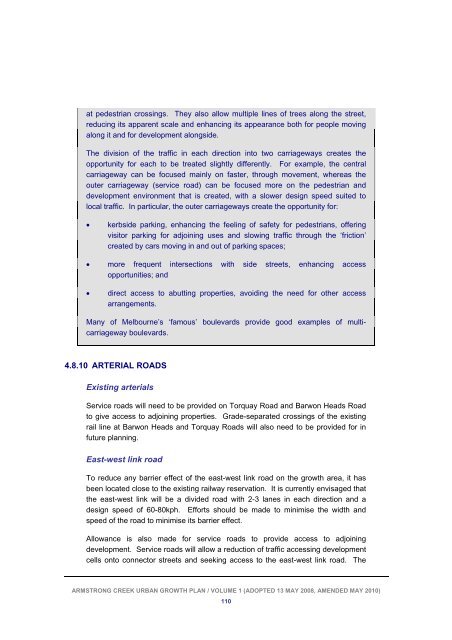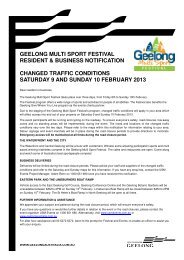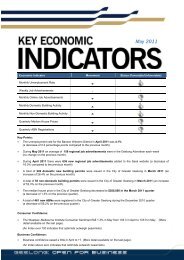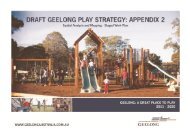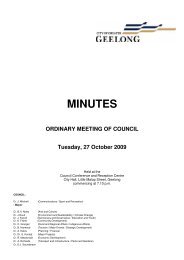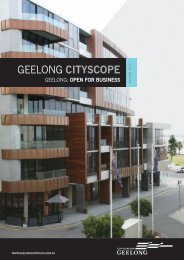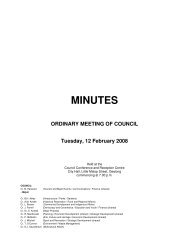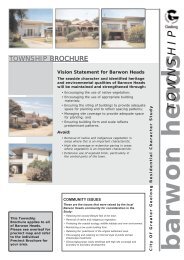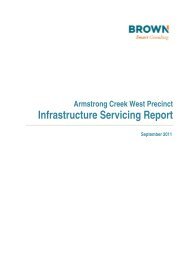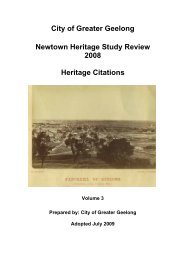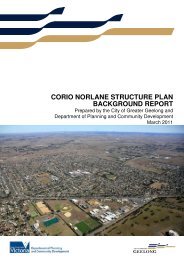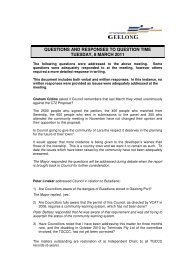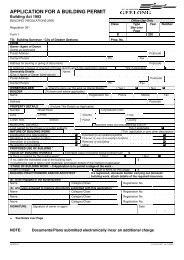armstrong creek urban growth plan volume 1 - City of Greater Geelong
armstrong creek urban growth plan volume 1 - City of Greater Geelong
armstrong creek urban growth plan volume 1 - City of Greater Geelong
You also want an ePaper? Increase the reach of your titles
YUMPU automatically turns print PDFs into web optimized ePapers that Google loves.
at pedestrian crossings. They also allow multiple lines <strong>of</strong> trees along the street,<br />
reducing its apparent scale and enhancing its appearance both for people moving<br />
along it and for development alongside.<br />
The division <strong>of</strong> the traffic in each direction into two carriageways creates the<br />
opportunity for each to be treated slightly differently. For example, the central<br />
carriageway can be focused mainly on faster, through movement, whereas the<br />
outer carriageway (service road) can be focused more on the pedestrian and<br />
development environment that is created, with a slower design speed suited to<br />
local traffic. In particular, the outer carriageways create the opportunity for:<br />
<br />
kerbside parking, enhancing the feeling <strong>of</strong> safety for pedestrians, <strong>of</strong>fering<br />
visitor parking for adjoining uses and slowing traffic through the ‘friction’<br />
created by cars moving in and out <strong>of</strong> parking spaces;<br />
more frequent intersections with side streets, enhancing access<br />
opportunities; and<br />
<br />
direct access to abutting properties, avoiding the need for other access<br />
arrangements.<br />
Many <strong>of</strong> Melbourne’s ‘famous’ boulevards provide good examples <strong>of</strong> multicarriageway<br />
boulevards.<br />
4.8.10 ARTERIAL ROADS<br />
Existing arterials<br />
Service roads will need to be provided on Torquay Road and Barwon Heads Road<br />
to give access to adjoining properties. Grade-separated crossings <strong>of</strong> the existing<br />
rail line at Barwon Heads and Torquay Roads will also need to be provided for in<br />
future <strong>plan</strong>ning.<br />
East-west link road<br />
To reduce any barrier effect <strong>of</strong> the east-west link road on the <strong>growth</strong> area, it has<br />
been located close to the existing railway reservation. It is currently envisaged that<br />
the east-west link will be a divided road with 2-3 lanes in each direction and a<br />
design speed <strong>of</strong> 60-80kph. Efforts should be made to minimise the width and<br />
speed <strong>of</strong> the road to minimise its barrier effect.<br />
Allowance is also made for service roads to provide access to adjoining<br />
development. Service roads will allow a reduction <strong>of</strong> traffic accessing development<br />
cells onto connector streets and seeking access to the east-west link road. The<br />
ARMSTRONG CREEK URBAN GROWTH PLAN / VOLUME 1 (ADOPTED 13 MAY 2008, AMENDED MAY 2010)<br />
110


